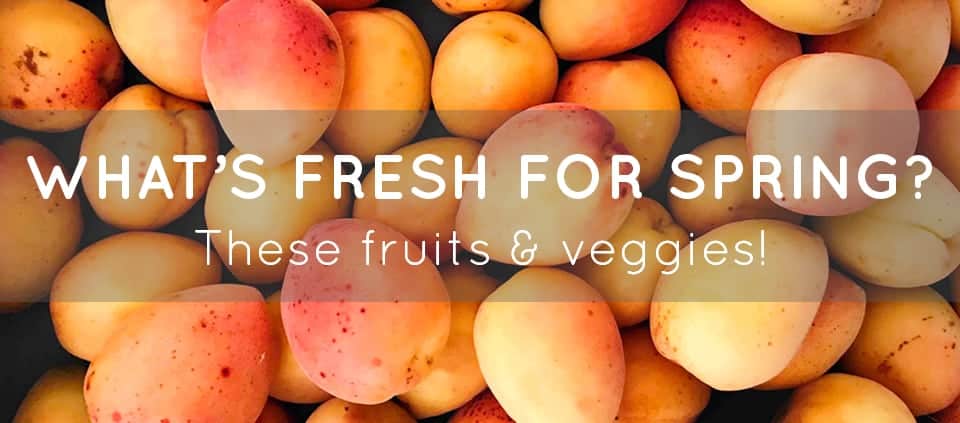What’s Fresh For Spring: Fruits & Veggies To Feed Your Baby (And Family)
Spring is almost here and we want to shout it from the rooftops! But since that might be a little over the top, we’ll celebrate by Instagramming our latest culinary creations featuring the freshest fruits and veggies you’ll find at the farmer’s market. Use our guide and your little one will be munching on delicious foods that are as healthy as they are tasty.

Apricots – Forget those shriveled, sugary dried fruits; now is the time to buy the real thing! Fresh apricots are fibrous and full of beta carotene as well as vitamin C. Moms and Dads will love apricots, too. All that fiber leaves you feeling full (with fewer calories), antioxidants can slow the aging process, and vitamin C, vitamin A, and phytonutrients will keep your skin glowing. Serve apricots and chicken as a main course for everyone!
Asparagus – Asparagus is one of the most well-balanced vegetables, as it’s high in folic acid, fiber, potassium, and pretty much the entire alphabet’s worth of vitamins. It’s unique from other vegetables in that it contains saponins, glutathione, and rutin, making it an antioxidant and anti-inflammatory powerhouse. Asparagus goes bad quickly, so prepare it within a day or two of purchasing it. It’s easy to do – asparagus can be eaten raw, baked, or steamed for a purée.
 Broccoli – This cancer-fighting machine is an antioxidant and anti-inflammatory. It’s also rich in kaempferol, which can help lessen allergy-related responses. If your baby has trouble with allergies, broccoli is a great choice. It’s chock full of vitamins and minerals, but the longer you cook the broccoli, the more you lose flavor and nutrients. Of course, most babies aren’t going to show an interest in eating raw broccoli (although they may love playing withit). With minimal steaming time, it’s a featured ingredient in many of our purée recipes.
Broccoli – This cancer-fighting machine is an antioxidant and anti-inflammatory. It’s also rich in kaempferol, which can help lessen allergy-related responses. If your baby has trouble with allergies, broccoli is a great choice. It’s chock full of vitamins and minerals, but the longer you cook the broccoli, the more you lose flavor and nutrients. Of course, most babies aren’t going to show an interest in eating raw broccoli (although they may love playing withit). With minimal steaming time, it’s a featured ingredient in many of our purée recipes.
Peas and Pea Shoots – Peas are the perfect tool for developing fine motor skills. Your little one can rake a pea pile, grasp a handful, and practice his thumb-and-finger pincer grasp. It’s its own reward, since a successful hold results in a tasty pea treat. If he ever tires of rolling peas around on his tray, pea shoots offer a new texture to play with and are also high in beta carotene, vitamin C, folate, and fiber.
Watercress – Watercress is a peppery, spicy aquatic green superfood. A little watercress goes a long way whether you’re a baby or an adult, so don’t overdo. Watercress is at its best when it’s fresh and raw; you can use it as a replacement for lettuce or spinach, or add it to neutral foods for a little kick. Cooked watercress packs less of a punch, so you can try steaming it for our watercress pesto and pasta recipe.
Mushrooms – Mushrooms are the opposite of watercress; they must be cooked if you want to access all of their nutritional benefits. Mushrooms are a good source of fiber and the typical vitamins, but they’re unique in that they contain an antioxidant called selenium. Selenium helps strengthen cells and tissues, and supports the immune system. There are several kinds of mushrooms, and all are tasty and nutritious. Those little white button mushrooms are one of the only non-animal sources of vitamin D, so this is an important addition to a vegan or vegetarian diet.
 Strawberries – Although strawberries smack of summertime, they’re actually at their peak between April and June. Their sweet taste is universally adored, and with plenty of fiber, potassium, and vitamin C, they’re healthy as well. If you’re ‘eating the rainbow,’ strawberries are one of the most scrumptious fruits and vegetables in the red category. The anthocyanins that make strawberries red act as antioxidants and can even decrease the likelihood of cancer and obesity.
Strawberries – Although strawberries smack of summertime, they’re actually at their peak between April and June. Their sweet taste is universally adored, and with plenty of fiber, potassium, and vitamin C, they’re healthy as well. If you’re ‘eating the rainbow,’ strawberries are one of the most scrumptious fruits and vegetables in the red category. The anthocyanins that make strawberries red act as antioxidants and can even decrease the likelihood of cancer and obesity.
Rhubarb – This underused vegetable tastes more like a fruit, and is most often found in pies. Its peak season is just two months long – April and May –so snag it now. Unlike other fruits and veggies, color isn’t indicative of flavor or ripeness, so focus on finding stalks that are firm and crisp, regardless of shade. With a lip-smacking sour taste, rhubarb shouldn’t be eaten raw; it shines when paired with a sweeter fruit. May we suggest this delicious strawberry and rhubarb parfait?
It’s not hard to figure out what’s in season. Just head to your local farmer’s market, where you’ll find the freshest local fruits and vegetables. The farmers are often happy to discuss the origins of their produce, and can even offer some insider secrets as to how to pick the best in a bunch. If you’ve never tried rhubarb or a certain type of mushroom, seize the spring day and try it out while it’s in season!





I’m going to make the strawberry rhubarb cake every Friday until rhubarb runs out. I made it once last year and thought it was the best thing ever. I love it so much